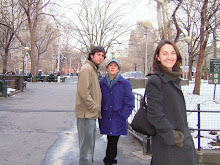A couple of days ago we took a ferry across the Gulf of Aqaba from
Nuweba in Egypt to Aqaba, Jordan. During the traveling, we met a nice
Belgian couple from Gent who thought it was ridiculous that we had
been to Maldegem (where we worked on the farm in Belgium). Apparently
Maldegem has a reputation for crazy country folk. We also befriended
a very friendly and helpful Egyptian man who works in Jordan. He
guided us through the process of getting ourselves and our bags to
Jordan and finding a hotel and bargained for us to make sure we paid
fair prices. It was incredible the way he would explain things to us
along the way just so we wouldn't worry. Together with the Belgians,
he joined us for dinner that night.
Early the next morning we took a bus to Wadi Rum. A Bedouin, named
Mujahad, with mostly false teeth and a very basic understanding of
English drove us through the desert. He had to hot wire the car (an
early 80s landcruiser?) to start it everytime we stopped. After
licking the tape on the casette a number of times halfway through our
drive there was a sudden 'pop' noise and then smoke came out of the
casette player. Later after hitting the casette tape over and over
against the steering wheel we had music again. Mujahad was a master at
making things work.
It wasn't as hot as expected. In the shade and even in the car with
the windows open it was perfect. We drove through huge sandstone
cliffs often seeing three or four camels resting in the sun. Besides
the camels the only signs of life were lizzard tracks ands lonely bird
perched on the sand or dotted shrubs. We saw an old Naabeten temple,
hiked up to a cool spring which had a beautiful view over the desert
and Wadi Rum village, and saw odd rock formations. A high rock bridge
and a giant rock with "legs" were the highlights. In the late
afternoon Majahad found a place in the shade of a rose-colored
sandstone cliff where he laid out a blanket and made tea. We stayed
for a while, and it was relaxing and peaceful. Only the noise of the
wind. At times the silence rings in your ears. Then he took us to a
beautiful red sand dune (the desert had white and red sand). The sand
looked so soft and so pure. Footprints quickly disappearing with the
shifting sand. He drove up ahead of us and let us walk for a little
bit. By late afternoon we were at the Bedouin camp where we'd spend
the night in a little tent in the middle of the desert. Other
tourists were there also from Italy, France, Spain and Japan. A
Sudanese chef cooked us dinner and breakfast, and we drank copious
amounts of sugared tea. Mujahad must have been the talented one
because after the sunset and the stars were out, he played a guitar-
like instrument and sang beautiful Bedouin songs around the fire. We
sat and listened for a long time as the scent of apple from his argile
(waterpipe) and fire filled the air. It was an almost out-of-body
experience the way the sounds and smells came together. At night it
didn't get so cold, but we did need fleeces.
The next day we took a bus to Petra. We walked about a mile through
the Siq, a huge and high sandstone mountain cut in half leaving a
turning and windswept passageway, which led to the impressive
Treasury, a beautiful and delicate tomb cut into the rose mountain.
Petra is an old city that has been cut into the mountainsides. Some
rooms are particulary beautiful in color with natural waves of blues,
whites, reds, pinks, yellow, and black. It looks like a painting all
over the walls and ceilings. We climbed to the top of a mountain,
called the High Place of Sacrifice that overlooks the city, and then
to other sites until our feet could take no more.
Jordanian people have been extraordinarily kind and generous. At
dinner the waiter brought us out desert and tea for free. At a sweet
shop, the owner gave us large samples to taste and charged us almost
nothing. Then we went to buy water and the grocery keeper gave us
sweets. Besides gifts people have gone out of their way to help make
us feel welcome and safe.
Keffiyahs are popular both with the tourists and Jordanians alike. The
keffiyah is a square head covering that is folded into a triangle and
rolled on the sides to stay on the head (sometimes with a thick black
band in on top). Traditionally Bedouins wear the red and white
keffiyeh, and we have heard Palestinians wear the black and white.
We're sure that other colors and patterns have other significance.
Most dress in long white or black robes. Some have pinstripes. Many
women in Jordan are either fully or mostly covered in black with only
a slit for the eyes. We've had barely any interaction with women.
Ramadan is finishing today or tomorrow. We are excited to see Eid.
We are heading to Amman today.
